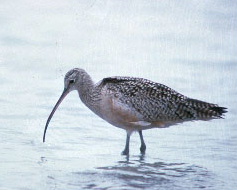Long-billed Curlew (Numenius americanus) - Wiki Long-billed Curlew
From Wikipedia, the free encyclopedia
[Photo] Long-billed Curlew from USFWS
The Long-billed Curlew, Numenius americanus, is a large shorebird. (See the Curlew family.)
Adults have a very long bill curved downwards, a long neck and a small head. The head, neck and underparts are light brown. The back is dark brown. They show cinnamon wing linings in flight.
Their breeding habitat is grasslands in west-central North America. Nests are located on the ground in open prairie. The female usually lays 4 eggs. Both parents look after the young.
They are short distance migrants and winter along coasts in the southern United States south to Mexico.
These birds forage in fields, picking up food by sight, also by probing. They mainly eat insects, but also eat crustaceans in coastal areas.
The population was significantly reduced at the end of the 19th century by hunting. Numbers have rebounded somewhat in more recent times.
This species was also called the 'candlestick bird'. Candlestick Point in San Francisco was named after this indigenous bird, and subsequently Candlestick Park inherited the name.
http://en.wikipedia.org/wiki/Long-billed_Curlew
| The text in this page is based on the copyrighted Wikipedia article shown in above URL. It is used under the GNU Free Documentation License. You may redistribute it, verbatim or modified, providing that you comply with the terms of the GFDL. |
